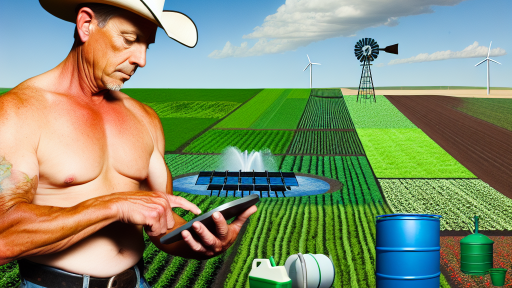Introduction to Flood Management
Importance for Farmers
Flood management is crucial for farmers and their crops.
It helps mitigate the risks of crop damage and soil erosion.
Effective flood management ensures that farm operations remain sustainable.
Farmers depend on timely information to manage flood risks effectively.
Without proper strategies, crops and livelihoods face significant threats.
Additionally, floods can disrupt the local economy and food supply.
For this reason, proactive measures are essential for success.
Understanding Flood Patterns
Understanding flood patterns is the first step in effective management.
Farmers should analyze historical data to identify trends.
This analysis allows them to anticipate potential flooding events.
Meteorological services often provide forecasts for extreme weather.
Farmers must stay informed about these potential disruptions.
Implementing Water Management Practices
Implementing robust water management practices is vital for farmers.
This includes creating drainage systems to direct excess water away.
Farmers can also utilize terraces to prevent soil erosion.
Transform Your Agribusiness
Unlock your farm's potential with expert advice tailored to your needs. Get actionable steps that drive real results.
Get StartedEstablishing retention ponds can help manage runoff.
These practices not only protect crops but also enhance soil health.
Utilizing Cover Crops
Cover crops are an effective flood management strategy.
They improve soil structure and absorb excess water.
Furthermore, cover crops can minimize nutrient runoff into waterways.
Choosing the right cover crops depends on local conditions.
Understanding the benefits of various crops will help farmers make informed choices.
Engaging with Community Resources
Farmers should engage with local community resources for support.
Collaborating with agricultural agencies provides access to valuable information.
Networking with other farmers allows for knowledge sharing.
Communities often have established plans for flood response.
Being part of these initiatives can strengthen individual resilience.
Understanding Flood Risks
Types of Flooding
Farmers face various types of flooding.
Flash floods occur with little warning.
River floods result from prolonged rainfall.
Coastal flooding affects areas near the ocean.
Urban flooding happens in cities due to stormwater runoff.
Causes of Flooding
Several factors contribute to flooding.
Heavy rainfall is a primary trigger.
Melting snow can lead to swollen rivers.
Deforestation increases surface runoff.
Poorly maintained drainage systems exacerbate the situation.
Land development alters natural water flow.
Impact on Agriculture
Flooding severely affects agricultural productivity.
Showcase Your Farming Business
Publish your professional farming services profile on our blog for a one-time fee of $200 and reach a dedicated audience of farmers and agribusiness owners.
Publish Your ProfileCrops can be submerged, leading to losses.
Soil erosion occurs during prolonged flooding.
Livestock may be at risk from rising water levels.
Farmers often face financial burdens due to damage.
Preparedness and Mitigation
Understanding flood risks helps farmers prepare.
Farmers can implement effective mitigation strategies.
They should develop a flood response plan.
Staying informed about weather warnings is crucial.
Investing in flood-resistant infrastructure can help.
Soil Management Practices
Enhancing Soil Drainage and Absorption
Effective soil management boosts drainage and absorption capabilities.
One crucial practice is to implement proper tillage methods.
Conventional tillage disrupts soil structure, affecting drainage.
In contrast, minimum tillage preserves soil health significantly.
Farmers should also consider creating furrows or ridges.
These structures encourage water flow and prevent pooling.
Furthermore, integrating cover crops improves soil quality.
Cover crops prevent soil erosion and enhance moisture retention.
Crop rotation can augment nutrient availability in the soil.
Different crops utilize nutrients differently, promoting balance.
Subsoiling is another practice that helps with drainage.
This technique breaks hardpan layers, allowing better water flow.
Adding organic matter significantly boosts soil structure.
Compost or well-rotted manure enriches soil and increases absorption.
Employing natural amendments like biochar can improve soil properties.
Biochar enhances water retention and nutrient availability.
Moreover, farmers should monitor soil moisture content regularly.
Utilizing moisture sensors provides real-time data for decision-making.
Ultimately, combining these strategies fosters resilient farming systems.
This holistic approach mitigates flood risks effectively.
Find Out More: Advanced Technologies in Agricultural Water Management
Creating Effective Water Management Systems: Ditches, Drains, and Retention Ponds
Importance of Water Management
Water management is crucial for successful farming.
It helps prevent crop damage during floods.
Effective systems enhance soil health and productivity.
Farmers can improve water management through various strategies.
Designing Ditches
Ditches provide a natural drainage solution for fields.
They help redirect excess water away from crops.
Farmers must create ditches with the proper slope.
A 2% slope generally offers effective drainage.
Additionally, regular maintenance keeps ditches clear of debris.
Types of Ditches
- Open ditches allow easy water flow and maintenance.
- Grass-lined ditches offer erosion control benefits.
- Vegetated ditches support wildlife habitats.
Implementing Drains
Drains provide targeted solutions for waterlogged areas.
Showcase Your Farming Business
Publish your professional farming services profile on our blog for a one-time fee of $200 and reach a dedicated audience of farmers and agribusiness owners.
Publish Your ProfileThey directly channel water away from sensitive crops.
Farmers can choose between surface and subsurface drainage systems.
Subsurface drains work well in clay soils.
Surface drains catch runoff from heavy rains.
Benefits of Drainage Systems
- Improves crop yield by reducing standing water.
- Enhances soil aeration and root growth.
- Minimizes the risk of disease caused by excess moisture.
Utilizing Retention Ponds
Retention ponds capture and store excess rainwater.
They provide a sustainable water source during dry seasons.
Proper design is key to maximizing their effectiveness.
Ponds should be strategically located to capture runoff.
Key Considerations for Retention Ponds
- Design ponds with adequate depth to hold water.
- Include vegetation around the edges for filtering.
- Regularly inspect for sediment buildup and wildlife impacts.
Integrating Systems for Optimal Results
Combining ditches, drains, and retention ponds enhances efficiency.
This integration creates a comprehensive water management plan.
Farmers should evaluate their land’s unique needs.
Regular assessment and adaptation are essential for success.
Delve into the Subject: Climate Change And Agricultural Market Trends
Crop Selection and Diversification
Choosing Flood-Resilient Varieties
Farmers face increasing challenges due to flooding.
Choosing the right crop varieties plays a crucial role in flood resilience.
Flood-resistant crops can survive extreme weather conditions.
This adaptability ensures better yields under difficult circumstances.
Farmers should prioritize varieties known for their resilience.
Additionally, diversifying crop types can mitigate risks significantly.
Understanding Flood-Resistant Varieties
Flood-resistant varieties are specially bred to withstand waterlogging.
Such crops often include certain types of rice and millet.
These plants can adapt to saturated soil conditions effectively.
Research shows that they yield better during flooding events.
Farmers should seek local seed varieties that offer flood resilience.
Benefits of Crop Diversification
Diversification is a proactive strategy for farmers.
By planting a mix of crops, risks are reduced significantly.
This approach can enhance soil health and biodiversity.
Additionally, it allows farmers to tap into different market demands.
In times of flood, some crops may thrive while others fail.
Implementing Resilient Crop Strategies
Farmers can implement resilient crop strategies in various ways.
They can rotate flood-resistant varieties within their fields.
Intercropping is another viable method to explore.
This technique promotes crop coexistence and reduces pest outbreaks.
Furthermore, employing cover crops can improve soil structure.
Farmers should also consider agroforestry as an option.
Seeking Expert Guidance
Consulting agricultural extension services can provide valuable insights.
These resources often offer information on suitable crop varieties.
Networking with other farmers can also yield practical knowledge.
Local agricultural organizations may facilitate workshops on crop resilience.
Staying informed empowers farmers to make better decisions.
Showcase Your Farming Business
Publish your professional farming services profile on our blog for a one-time fee of $200 and reach a dedicated audience of farmers and agribusiness owners.
Publish Your ProfileYou Might Also Like: Climate-Resilient Farming Practices to Save Water
Utilizing Technology: Drones and Sensors for Monitoring Flood Conditions
The Role of Drones in Flood Management
Drones offer real-time aerial imagery of agricultural fields.
They help farmers assess flood conditions quickly and accurately.
Farmers can easily identify waterlogged areas using drone technology.
This process enables efficient resource allocation during floods.
Furthermore, drones can access hard-to-reach areas with ease.
Benefits of Using Sensors
Sensors provide precise measurements of soil moisture levels.
These devices help farmers make informed decisions about irrigation.
Additionally, they can monitor water flow in real time.
This capability assists in predicting potential flooding events.
Installing sensors in fields can enhance early warning systems.
Integrating Drones and Sensors
Combining drones and sensors creates a comprehensive monitoring system.
This integration allows for enhanced data collection and analysis.
Farmers can receive timely updates on changing flood conditions.
Consequently, they can implement proactive measures quickly.
Moreover, this synergy fosters collaboration among agricultural stakeholders.
Case Studies and Success Stories
Several farms have successfully adopted drone technology amidst flooding.
Green Mountain Farms reported improved crop protection with drones.
Lakeside Cooperative utilized sensors to minimize water damage.
These examples demonstrate the effectiveness of innovative flood management.
Moreover, they inspire other farmers to leverage technology for monitoring.
Learn More: Impact of Greenhouse Gases on Agricultural Productivity

Government Policies and Support Programs
Understanding Financial Aid
Farmers face numerous challenges during floods.
Financial aid plays a crucial role in flood management.
It helps mitigate losses and rebuild affected areas.
Several programs exist to support farmers during these times.
Notably, both federal and state governments offer assistance.
Federal Assistance Programs
The U.S. Department of Agriculture provides critical support.
One program is the Emergency Conservation Program.
This program helps farmers recover from natural disasters.
Additionally, the Federal Crop Insurance program safeguards incomes.
Farmers can enroll to protect against yield losses.
State-Level Support Initiatives
Many states also implement their own aid programs.
For example, the California Department of Food and Agriculture offers grants.
These grants cover flood damage repair costs.
Furthermore, some states provide low-interest loans to farmers.
This financial support helps farmers recover quickly.
Local Resources and Community Programs
Local organizations play a vital role in flood support.
Community resource centers often provide grants and aid.
Farmers can access workshops on flood preparedness.
Showcase Your Farming Business
Publish your professional farming services profile on our blog for a one-time fee of $200 and reach a dedicated audience of farmers and agribusiness owners.
Publish Your ProfileAdditionally, local agricultural extension offices offer guidance.
These resources facilitate timely recovery efforts.
How to Access These Resources
Farmers should stay informed about available programs.
They can contact local USDA offices for assistance.
Moreover, online platforms provide updates on new programs.
Networking with other farmers can also be beneficial.
Sharing experiences can lead to valuable insights.
Community Engagement and Collaboration
Importance of Building Networks
Building networks among farmers enhances collective knowledge.
This collaboration leads to better flood management strategies.
Sharing resources can significantly reduce individual costs.
Effective communication fosters trust and collaboration.
Creating Local Partnerships
Local partnerships empower farmers to share insights.
Collaborating with local government increases resource availability.
Engaging with community organizations broadens support options.
Farmers can learn from each other’s experiences in flood management.
Utilizing Technology for Collaboration
Technology helps streamline communication among farmers.
Online platforms enable sharing vital information quickly.
A mobile app can provide updates on weather and flood alerts.
Farmers can exchange tips and resources through social media.
Hosting Informational Workshops
Workshops create a space for learning and discussion.
Farmers can present their successful strategies and tools.
Experts can provide insights on best practices in flood management.
Such events strengthen community bonds and foster collaboration.
Case Study: Successful Collaboration
A group of farmers in Willow Creek developed a network.
They shared equipment for flood prevention techniques.
This collaboration resulted in reduced costs and improved efficiency.
Communication increased their collective ability to respond.
Case Studies: Successful Flood Management in Agriculture
Innovative Techniques from Farmers in Asia
Farmers in Bangladesh implemented raised bed farming to combat flooding.
This method involves planting crops on elevated beds.
It significantly reduces crop loss during floods.
Additionally, this technique enhances soil drainage.
Farmers have reported increased yields despite extreme weather events.
Community-Based Flood Resilience in the Netherlands
The Netherlands faces unique challenges due to its geography.
Farmers collaborated with local governments for flood management systems.
One effective strategy includes creating water retention areas.
These areas help to absorb excess rainfall and prevent overflow.
As a result, agricultural productivity remains stable in these regions.
Success Stories from the United States
In the Midwest, farmers have adopted contour farming techniques.
This practice involves plowing across the slope of the land.
It effectively reduces soil erosion during heavy rains.
Showcase Your Farming Business
Publish your professional farming services profile on our blog for a one-time fee of $200 and reach a dedicated audience of farmers and agribusiness owners.
Publish Your ProfileMoreover, it enhances water conservation in the soil.
Farmers noticed a positive impact on crop resilience and health.
Utilizing Technology for Flood Forecasting
Farmers in Australia have turned to advanced weather technologies.
They rely on satellite imagery and data analytics for flood predictions.
This information allows them to make timely decisions about crop management.
In turn, it helps minimize potential losses during flood seasons.
This proactive approach showcases the importance of technology in modern agriculture.
Collaboration with Research Institutions
Farmers in Brazil have partnered with universities to enhance flood resilience.
Through this collaboration, they developed drought-resistant crop varieties.
These crops thrive in saturated soil conditions.
This initiative has proven particularly effective in flood-prone regions.
Farmers now report higher resilience in their yields despite flooding events.
Summarizing Best Practices for Effective Flood Management
Understanding Key Strategies
Farmers must adopt a proactive approach to flood management.
Effective flood management begins with knowledge of the local environment.
Next, implementing proper drainage systems is crucial.
Farmers should also consider the use of cover crops.
Additionally, they can employ contour farming techniques.
Adopting Innovative Technologies
Modern technology plays a significant role in flood management.
Farmers can utilize weather forecasting tools effectively.
Moreover, sensors help monitor soil moisture levels regularly.
Implementing drones can assess field conditions efficiently.
Furthermore, mobile apps can assist in timely decision-making.
Collaborating with Local Authorities
Engagement with local authorities enhances flood preparedness.
Farmers should participate in community planning initiatives.
Working closely with government agencies offers vital resources.
Collaboration can lead to shared knowledge and best practices.
Ultimately, cohesive efforts strengthen flood resilience.
Establishing an Emergency Response Plan
An emergency response plan is essential for effective flood management.
Farmers should identify potential flood threats specific to their area.
Creating a communication strategy ensures timely alerts.
Regular drills help familiarize the community with the plan.
Additionally, preparing emergency supplies is critical.
Engaging in Continuous Education
Continuous education equips farmers with up-to-date knowledge.
Regular workshops can cover the latest flood management techniques.
Online courses also provide accessible learning options.
Engagement with agricultural extension services supports growth.
Ultimately, education fosters resilience against flooding events.
Additional Resources
Priorities for California’s Water – Public Policy Institute of California
Climate Change Impacts on Agriculture and Food Supply | US EPA




